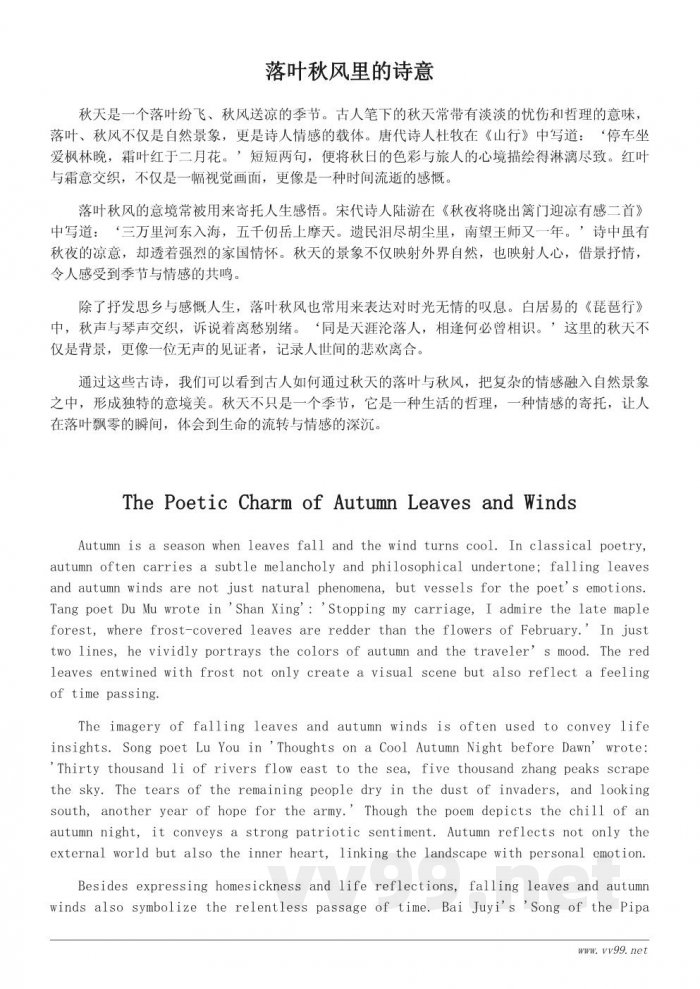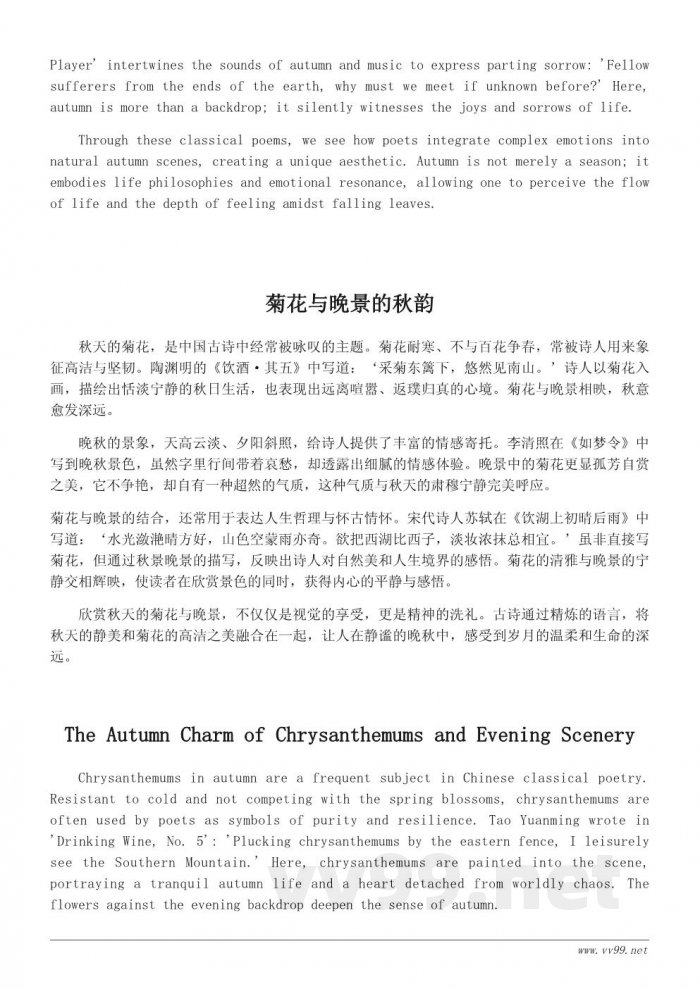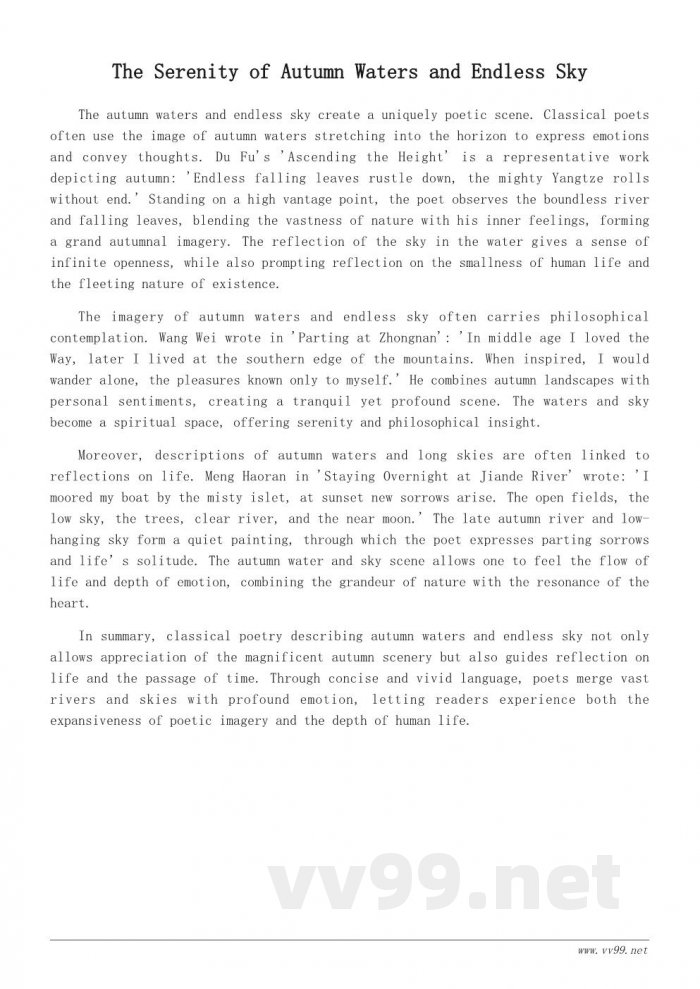落叶秋风里的诗意
秋天是一个落叶纷飞、秋风送凉的季节。古人笔下的秋天常带有淡淡的忧伤和哲理的意味,落叶、秋风不仅是自然景象,更是诗人情感的载体。唐代诗人杜牧在《山行》中写道:‘停车坐爱枫林晚,霜叶红于二月花。’短短两句,便将秋日的色彩与旅人的心境描绘得淋漓尽致。红叶与霜意交织,不仅是一幅视觉画面,更像是一种时间流逝的感慨。
落叶秋风的意境常被用来寄托人生感悟。宋代诗人陆游在《秋夜将晓出篱门迎凉有感二首》中写道:‘三万里河东入海,五千仞岳上摩天。遗民泪尽胡尘里,南望王师又一年。’诗中虽有秋夜的凉意,却透着强烈的家国情怀。秋天的景象不仅映射外界自然,也映射人心,借景抒情,令人感受到季节与情感的共鸣。
除了抒发思乡与感慨人生,落叶秋风也常用来表达对时光无情的叹息。白居易的《琵琶行》中,秋声与琴声交织,诉说着离愁别绪。‘同是天涯沦落人,相逢何必曾相识。’这里的秋天不仅是背景,更像一位无声的见证者,记录人世间的悲欢离合。
通过这些古诗,我们可以看到古人如何通过秋天的落叶与秋风,把复杂的情感融入自然景象之中,形成独特的意境美。秋天不只是一个季节,它是一种生活的哲理,一种情感的寄托,让人在落叶飘零的瞬间,体会到生命的流转与情感的深沉。
The Poetic Charm of Autumn Leaves and Winds
Autumn is a season when leaves fall and the wind turns cool. In classical poetry, autumn often carries a subtle melancholy and philosophical undertone; falling leaves and autumn winds are not just natural phenomena, but vessels for the poet's emotions. Tang poet Du Mu wrote in 'Shan Xing': 'Stopping my carriage, I admire the late maple forest, where frost-covered leaves are redder than the flowers of February.' In just two lines, he vividly portrays the colors of autumn and the traveler’s mood. The red leaves entwined with frost not only create a visual scene but also reflect a feeling of time passing.
The imagery of falling leaves and autumn winds is often used to convey life insights. Song poet Lu You in 'Thoughts on a Cool Autumn Night before Dawn' wrote: 'Thirty thousand li of rivers flow east to the sea, five thousand zhang peaks scrape the sky. The tears of the remaining people dry in the dust of invaders, and looking south, another year of hope for the army.' Though the poem depicts the chill of an autumn night, it conveys a strong patriotic sentiment. Autumn reflects not only the external world but also the inner heart, linking the landscape with personal emotion.
Besides expressing homesickness and life reflections, falling leaves and autumn winds also symbolize the relentless passage of time. Bai Juyi's 'Song of the Pipa Player' intertwines the sounds of autumn and music to express parting sorrow: 'Fellow sufferers from the ends of the earth, why must we meet if unknown before?' Here, autumn is more than a backdrop; it silently witnesses the joys and sorrows of life.
Through these classical poems, we see how poets integrate complex emotions into natural autumn scenes, creating a unique aesthetic. Autumn is not merely a season; it embodies life philosophies and emotional resonance, allowing one to perceive the flow of life and the depth of feeling amidst falling leaves.
菊花与晚景的秋韵
秋天的菊花,是中国古诗中经常被咏叹的主题。菊花耐寒、不与百花争春,常被诗人用来象征高洁与坚韧。陶渊明的《饮酒·其五》中写道:‘采菊东篱下,悠然见南山。’诗人以菊花入画,描绘出恬淡宁静的秋日生活,也表现出远离喧嚣、返璞归真的心境。菊花与晚景相映,秋意愈发深远。
晚秋的景象,天高云淡、夕阳斜照,给诗人提供了丰富的情感寄托。李清照在《如梦令》中写到晚秋景色,虽然字里行间带着哀愁,却透露出细腻的情感体验。晚景中的菊花更显孤芳自赏之美,它不争艳,却自有一种超然的气质,这种气质与秋天的肃穆宁静完美呼应。
菊花与晚景的结合,还常用于表达人生哲理与怀古情怀。宋代诗人苏轼在《饮湖上初晴后雨》中写道:‘水光潋滟晴方好,山色空蒙雨亦奇。欲把西湖比西子,淡妆浓抹总相宜。’虽非直接写菊花,但通过秋景晚景的描写,反映出诗人对自然美和人生境界的感悟。菊花的清雅与晚景的宁静交相辉映,使读者在欣赏景色的同时,获得内心的平静与感悟。
欣赏秋天的菊花与晚景,不仅仅是视觉的享受,更是精神的洗礼。古诗通过精炼的语言,将秋天的静美和菊花的高洁之美融合在一起,让人在静谧的晚秋中,感受到岁月的温柔和生命的深远。
The Autumn Charm of Chrysanthemums and Evening Scenery
Chrysanthemums in autumn are a frequent subject in Chinese classical poetry. Resistant to cold and not competing with the spring blossoms, chrysanthemums are often used by poets as symbols of purity and resilience. Tao Yuanming wrote in 'Drinking Wine, No. 5': 'Plucking chrysanthemums by the eastern fence, I leisurely see the Southern Mountain.' Here, chrysanthemums are painted into the scene, portraying a tranquil autumn life and a heart detached from worldly chaos. The flowers against the evening backdrop deepen the sense of autumn.
In late autumn, the sky is high and clouds are light, with the setting sun casting slanting rays, providing poets with rich emotional inspiration. Li Qingzhao in 'Like a Dream' describes the late autumn scene, conveying delicate emotions through subtle melancholy. Chrysanthemums in the evening are admired for their solitary beauty; they do not compete, yet possess a transcendent quality that perfectly harmonizes with the solemn and serene autumn.
The combination of chrysanthemums and evening scenery is also used to express life philosophy and nostalgia. Song poet Su Shi wrote in 'On West Lake After Rain': 'The shimmering water is best under clear skies, the misty mountains are magical in the rain. To compare West Lake to Xi Zi, light or heavy makeup suits her equally.' While not directly mentioning chrysanthemums, the depiction of autumnal evening scenery reflects the poet’s appreciation of nature’s beauty and life’s subtleties. The elegance of chrysanthemums combined with serene evenings allows readers to experience inner peace and reflection.
Enjoying chrysanthemums and evening views in autumn is not just a visual delight but a spiritual experience. Classical poetry, with its concise language, merges the quiet beauty of autumn with the refined charm of chrysanthemums, letting one feel the gentle passage of time and the depth of life amid the serene late autumn.
小提示:上面此文档内容仅展示完整文档里的部分内容, 若需要下载完整文档请 点击免费下载完整文档 。





